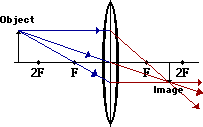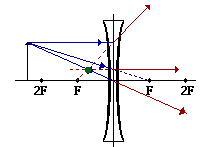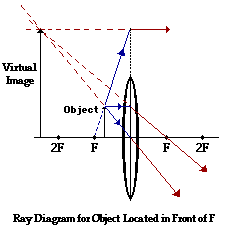IV. Lenses: Explanation
A. Ray diagrams:
 |
 |
Converging lens
(Notice that rays spread out after f. |
Diverging lens |
B. Three special rays shown below are:
- Convex Lens: Ray going in parallel to axis goes out through f.
(Diverging Lens: Ray goes out as if from f on other side.
- Convex: Ray going in through f, goes out parallel to axis.
(Div. Going in toward f on far side, …)
- Ray going through center of lens, keeps going in straight line.
- Draw these 3 rays from a point on the object.
The point where these 3 (actually, all) rays from a certain point meet, is the image of that point.
- Hint: Put one end of object on the "principal" axis of the lens. Then you only need to use 3 rays from the other extreme of the object.



C. Look at the ray diagrams on the web sites below:
-
Converging lenses
Basic rays done in simple steps.
By Selman Hershfield, U. Florida.
Drag object and image moves. See many rays with 3 special ones highlighted.
U. Wisconsin.
Same thing mirrored at
Mississippi State
- Optics of the eye.
This ShockWave applet illustrates the principle of accommodation in the eye. The user adjusts the distance between eye and object and sees the resulting ray diagram, the image size, and the lens shape.
By Pascal Renault
- Diverging lens
Drag object and image moves. See many rays with 3 special ones highlighted.
U. Wisconsin
and mirrored at
Mississippi State.
- Converging and diverging lenses and mirrors.
Change + or - f, lens or mirror. Drag object, see 3 special rays, M, and distances.
By Fu-Kwan Huang. (It uses "p" for distance of object and "q" for distance of image.)
Tutorial by
Glenbrook High School students.
Tutorial by
Clarence Bakken.
Problems to do.
Index for Lenses.
Andria Erzberger
2/1/01






